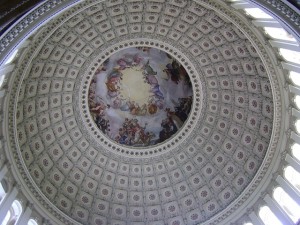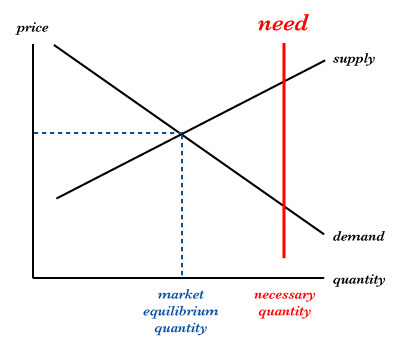
How do we provide the best possible healthcare for the most people and how do we pay for it? Those are not purely scientific questions, but I have some personal and professional interest in how we answer those questions, as a healthcare consumer and someone whose job connects to the health sector at multiple points. Last week’s nonvote on a replacement for the Affordable Care Act was undoubtedly a milestone in the conversation about those questions, but it was not the final word by any stretch. Healthcare costs continue to outpace overall economic growth, quality of care is not as high as it could be, and not everyone has insurance coverage that allows them to afford the care they need. So there is work left to be done, and I think a little math and a little evolutionary biology can help us frame the challenges a little more clearly.
Two of our goals, expanding insurance coverage and reducing costs, have a complex relationship. Naïvely, expanding coverage might seem likely to raise costs simply because we are paying for healthcare for more people. On the other hand, if we reduce costs we would expect to be able to pay for healthcare for more people while spending the same amount of money. Human behavior can complicate this picture somewhat. One justification for expanding coverage as a cost-savings measure is to encourage people to get relatively inexpensive preventive care because they have insurance, whereas without insurance they are more likely to wait until they need more expensive emergency care. Then again, there is some evidence that, at least in the short term, providing more people health insurance increases use of expensive emergency services. Possible explanations are that people who primarily used emergency services for healthcare in the past will continue to do so until they learn what other options are available or find doctors that meet their needs, or that people were actually avoiding healthcare altogether when they didn’t have insurance but will use it for similar circumstances when they do have insurance.
Given this economic landscape, I can appreciate the appeal of letting a free market sort it all out. After all, economic markets have an evolutionary flavor. Businesses which attract more consumer dollars will be able to grow and expand more or faster, the economic equivalent to reproducing. Such natural selection is adaptive and contextual, allowing it to respond quickly and dynamically to an ever-shifting array of human behaviors and needs without the need for a central planner. In a variety of economic domains, the free market achieves precisely that outcome. Yet I am skeptical that healthcare costs can be solved purely with markets.
Natural selection is an optimization algorithm, a process for searching through possible solutions to find the best one. It does not try every possible solution; such an exhaustive search is impractical both in terms of time and available resources. But an exhaustive search is the only way to guarantee finding the absolute best solution. Natural selection and other optimization algorithms trade some certainty about finding the best solution in exchange for greater efficiency finding a solution that is at least good enough. Those efficiency gains are achieved by making some assumptions about the optimization problem and the kinds of solutions that will be optimal. As a result, optimization algorithms perform best on problems that match their assumptions and poorly on all other problems.

 )
)In other words, no optimization algorithm can solve all problems efficiently. For example, natural selection is not well suited to problems which require a large number of simultaneous mutations to get from one functional variation to another with the intermediate variations all being nonfunctional. If you had to go directly from a fish to a bird, for example, natural selection would probably never get you a bird.
Free markets are also an optimization algorithm. One of the quantities they are meant to optimize is price subject to constraints like supply and demand. The economics 101 version says that increases in supply tend to drive prices down, while increases in consumer demand drive prices up. Somewhere there is an optimal price to charge that balances between the two drivers and the market will select for businesses that charge closest to that price. Charge more than demand supports and you lose customers to businesses charging a lower price. Charge less than supply allows and you’ll be without product to sell or out of business because sales don’t cover your costs. And so on until only the businesses charging the optimal price remain.
Healthcare demand curves don’t always look like the Econ 101 version, however. Demand does not change as sharply as price changes; health needs remain the same independent of cost and people are willing to go to greater lengths to pay for them than they would for many other goods and services. That changes the dynamic of the selection behavior on price, reducing the pressure to keep costs down.
Insurance introduces another layer to consider. Health insurance has expanded in scope beyond protecting against catastrophe; it has become a way to finance all healthcare costs. As a result, the price many of us pay is our insurance premium rather than actual heathcare costs. Paying indirectly further reduces the consumer-driven selection pressure on the price of healthcare itself.
Finally, we have other constraints on our optimization problem, such as maximizing the number of people with coverage. Market optimization isn’t necessarily guaranteed to satisfy those additional constraints. For example, covering patients with pre-existing conditions would appear to require policy enforcement.
Free market optimization functions as desired in many scenarios, but as with any optimization algorithm it cannot solve all problems. Based on my admittedly simplified and low-resolution analysis, I believe healthcare is one of the problems for which it is not well suited. Making some analogies to natural selection helps me organize my thoughts, but maybe those analogies send me down the wrong mental path. Nevertheless, we need to find useful solutions, so I think keeping the conversation going is necessary even if we take some wrong turns along the way.
Do you find it helpful to connect complicated problems in other domains to more familiar scenarios? Which analogies are most fruitful, or most muddling? Do you have different insights about how to achieve our healthcare goals?
Andy has worn many hats in his life. He knows this is a dreadfully clichéd notion, but since it is also literally true he uses it anyway. Among his current metaphorical hats: husband of one wife, father of two teenagers, reader of science fiction and science fact, enthusiast of contemporary symphonic music, and chief science officer. Previous metaphorical hats include: comp bio postdoc, molecular biology grad student, InterVarsity chapter president (that one came with a literal hat), music store clerk, house painter, and mosquito trapper. Among his more unique literal hats: British bobby, captain’s hats (of varying levels of authenticity) of several specific vessels, a deerstalker from 221B Baker St, and a railroad engineer’s cap. His monthly Science in Review is drawn from his weekly Science Corner posts — Wednesdays, 8am (Eastern) on the Emerging Scholars Network Blog. His book Faith across the Multiverse is available from Hendrickson.

We need to remember that the invisible hand of the free market sometimes wears brass knuckles. The free market is about maximizing wealth, which is a different goal than improving health. As you eloquently point out, thinking that the free market will solve the healthcare problem is using the wrong tool for the problem.
Thanks! The brass knuckles idea is a vivid and apt image.